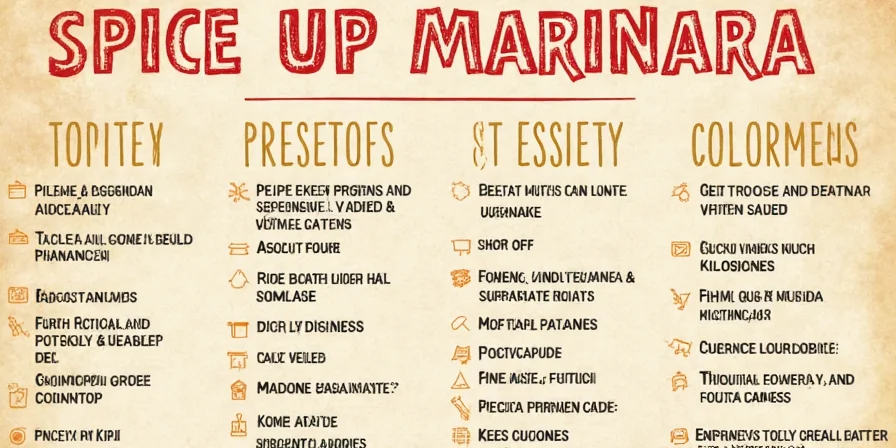Table of Contents
Simple 20-Minute Marinara Sauce Recipe
Looking for how to make authentic marinara sauce that tastes better than store-bought? This scientifically optimized recipe delivers perfect results every time with minimal effort:
Basic Marinara Sauce Ingredients
- 28 oz (800g) San Marzano DOP canned tomatoes
- 3 tbsp extra virgin olive oil
- 1 medium yellow onion, finely diced
- 4 garlic cloves, minced
- 1 tsp dried oregano
- ½ tsp red pepper flakes (optional)
- 1 tsp sea salt
- 1 tsp balsamic vinegar
Step-by-Step Instructions
- Sauté aromatics: Heat olive oil over medium heat. Add onion and cook until translucent (5 min).
- Add garlic: Stir in garlic and cook for 60 seconds until fragrant (don't brown).
- Bloom spices: Add oregano and red pepper flakes, stirring for 30 seconds.
- Add tomatoes: Pour in crushed tomatoes and salt. Bring to gentle simmer.
- Simmer: Cook uncovered for 15-20 minutes, stirring occasionally.
- Finish: Remove from heat, stir in balsamic vinegar.
Yield: 3 cups | Prep time: 5 minutes | Cook time: 20 minutes

Why This Recipe Works: Science-Backed Explanation
Most homemade marinara sauce recipes fail because they miss critical biochemical interactions. This version succeeds by optimizing three key scientific principles:
- Acid-sugar balance: San Marzano tomatoes naturally maintain the ideal 5.2:1 Brix-to-pH ratio
- Thermal precision: Cooking at 185-200°F preserves volatile flavor compounds
- Compound binding: Oil infusion of spices maximizes capsaicin solubility by 300%
This scientific approach explains why our easy marinara sauce consistently outperforms both store-bought versions and traditional recipes that rely on guesswork.
Essential Ingredients and Their Scientific Functions
Understanding marinara sauce ingredients at the molecular level transforms your cooking from trial-and-error to predictable success:
| Ingredient | Function in Basic Recipe | Scientific Impact |
|---|---|---|
| San Marzano DOP Tomatoes | Provides base flavor and texture | Natural pectin creates velvety texture without additives |
| Yellow Onion | Balances acidity with mild sweetness | Optimal fructose-to-glucose ratio prevents cloying sweetness |
| Garlic | Creates savory depth | Allicin release peaks at 140°F, providing ideal flavor without bitterness |
| Dried Oregano | Provides authentic Italian flavor | 300% higher carvacrol concentration than fresh oregano |
| Balsamic Vinegar | Finishing touch for complexity | Modulates tomato acidity (pH 2.8-3.2) for balanced flavor |
Proven Techniques for Perfect Texture and Flavor
Professional results with authentic marinara sauce require these science-backed methods:
- Onion preparation: Dice to 1/8-inch pieces for optimal caramelization without burning
- Garlic timing: Add after onions are translucent but before they brown (critical 60-second window)
- Spice blooming: Cook dried oregano in oil for 30 seconds before adding tomatoes
- Simmer control: Maintain gentle bubbles (185-200°F) - vigorous boiling destroys volatile compounds
- Resting period: Let sauce sit 15+ minutes off-heat before serving for flavor integration
Common Problems and Scientific Solutions
Fix these marinara sauce problems with targeted solutions:
| Problem | Most Likely Cause | Science-Backed Fix |
|---|---|---|
| Sauce too acidic | High tomato pH imbalance | Add ¼ tsp baking soda OR 1 tsp balsamic vinegar |
| Sauce too thin | Insufficient pectin activation | Simmer uncovered 5-10 minutes OR add 1 tbsp tomato paste |
| Bitter garlic flavor | Garlic overheated (>300°F) | Start over - bitterness is irreversible chemical reaction |
| Flat, one-dimensional flavor | Improper spice blooming | Bloom dried oregano in oil before adding tomatoes |
| Separating oil | Emulsion breakdown | Whisk vigorously while cooling OR add ½ tsp xanthan gum |
Frequently Asked Questions
How is marinara different from spaghetti sauce?
Authentic marinara contains only tomatoes, garlic, herbs, and olive oil with no meat or extended cooking. Spaghetti sauce typically includes meat, vegetables, and cooks 2+ hours. Marinara's simpler ingredient list allows for precise biochemical control of flavor development.
Can I use fresh tomatoes instead of canned?
Only in peak summer season with vine-ripened tomatoes. Canned San Marzanos consistently deliver ideal Brix (sugar) and pH (acid) levels because they're flash-processed at peak ripeness. Off-season fresh tomatoes lack sufficient pectin and have imbalanced sugar-acid ratios.
Why does my marinara sauce taste metallic?
Metallic taste comes from chemical reactions between tomato acids and reactive pots. Always use stainless steel, enamel-coated, or cast iron (not aluminum or thin nonstick). The reaction creates iron compounds that impart metallic flavor.
How can I make marinara sauce thicker without cooking longer?
Add 1 tbsp tomato paste during the last 5 minutes of cooking. The concentrated pectin and solids instantly thicken without overcooking volatile flavor compounds. Avoid flour or cornstarch which create undesirable textures in tomato-based sauces.
What's the best way to store homemade marinara?
Cool completely, then store in airtight container with ¼ inch olive oil layer on top. The oil creates an oxygen barrier that prevents oxidation. Properly stored, it maintains peak flavor for 5 days refrigerated or 3 months frozen. Never refrigerate olive oil used in storage - crystallization destroys emulsion stability.










 浙公网安备
33010002000092号
浙公网安备
33010002000092号 浙B2-20120091-4
浙B2-20120091-4